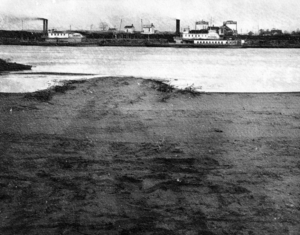The Missouri River corridor and the territory that would become Omaha was a global identity and a profitable business investment as much as four centuries ago! Fur trappers from Europe and the East came for beaver to produce top hats highly desired by the gentry of Europe. One requirement for hiring was that the worker could not swim, a protection that could prevent workers from jumping ship. The fur traders went north only as far as the Mandan Indian Villages in the Dakotas. Lewis and Clark and the Corps of Discovery in 1804 were the first to go beyond.
Territory west of the Missouri River was not open to settlement until after President Franklin Pierce signed the Kansas-Nebraska Act on April 30, 1854. However, prior to that hundreds of adventurers passed through what would become Omaha in search of gold and other riches further west. But Bill Brown in 1850 decided his gold could be found right here, and he established the area’s first ferry business. His Lone Tree Ferry was named for his landing point near the single tree on the western bank. By 1854, when “Omaha City” was founded, his ferries were large enough to transport herds of cattle and wagons. Brown is considered the founder of Omaha because in 1853, a year before it was legal, Native American permitted Brown to quietly stake out a town site of 232 city square blocks for a consortium of businessmen from Kanesville (Council Bluffs). This likely was in appreciation of Bill’s provision of lower fees or spirits for them! Research conducted by the Douglas County Historical Society has determined that Brown’s ferry landing was in the midst of the field of wild flowers bordered by Abbott Drive, Harry A. Trustin Riverfront Drive and Gallup University, a site that today is inland from the Missouri River due to nature and man-made channel changes.
